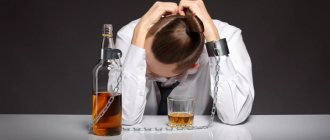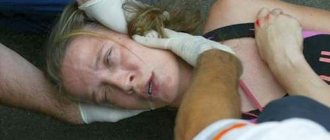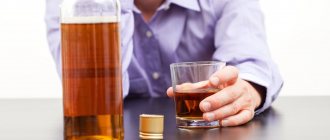Alcoholic psychosis is a mental disorder resulting from prolonged alcoholism. The clinical picture of different psychoses may vary significantly, but the cause and result of such mental disorders are the same: the cause is alcoholism, the result is mandatory hospitalization.
Alcoholic psychosis is a very dangerous disease, due to which a person can pose a real danger to others.
General symptoms:
- increased irritability, when everything irritates you for no reason;
- obvious sleep disturbance, almost insomnia;
- high anxiety: people gripped by alcoholic psychosis become very suspicious, they are frightened by the slightest rustle, the appearance of an unfamiliar face, any surprise - everything can drive the patient to hysterics;
- a sharp, unjustified change of mood;
- partial memory loss, when a person cannot remember some moments;
- hallucinations that the patient takes for reality and which have a significant impact on him.
Alcohol psychosis causes
Very often, the cause of the development of alcoholic psychosis may be a genetic predisposition. Much less common are living conditions and social environment. The next reason may be the abuse of alcoholic beverages for 3-5 years, which disrupts metabolism and affects internal organs.
Recently, there has been a “rejuvenation” in the age of drinkers. Already in adolescence, boys, and often girls, begin to drink alcohol in the form of energy drinks. The nervous system at this age is not yet formed at the proper level, which entails the body becoming addicted to alcohol and becomes a subsequent cause of the disease.
Additional motivating factors are:
- social and household factor;
- genetic predisposition;
- metabolic and blood chemical disorders;
- long-term stress, mental trauma;
- chronic fatigue, apathy;
- physical and mental overload;
- low level of comfort.
Symptoms of alcoholic psychosis
The symptoms of alcoholic psychosis depend entirely on the type that manifests itself in a particular person. However, general symptoms of this disease can be identified:
- Mood swings.
- Continuous movements.
- Expressive facial expressions.
- Delusions, hallucinations and disorientation.
- Changing your sleep pattern.
- Tremor of the limbs.
- Change in skin color.
Delirium tremens begins with insomnia, sweating, depression and sudden mood swings. Periodically, a person feels normal, and then hallucinations and delusions occur. This provokes the mobility of the patient, who tries to cope with the problems that he sees. Here he can scream, wave his arms, etc.
Treatment of patients with alcoholic psychoses
P
psychotic states that arise in some patients with alcoholism as a result of many years of alcohol abuse are very diverse in clinical manifestations, severity of the condition and duration of the course. The most severe psychoses are those accompanied by severe confusion (delirium). The second most common category is occupied by acute alcoholic hallucinosis. These two types of alcoholic psychoses account for approximately 90% of all psychotic conditions caused by alcohol abuse. Much less common are acute alcoholic paranoids, protracted hallucinosis, and alcoholic delusions of jealousy. A special group consists of alcoholic encephalopathies, accompanied by the appearance of psychotic symptoms. Therapy for different types of alcoholic psychoses varies significantly, which forces us to consider separately the treatment of patients with delirium, hallucinosis, paranoid and alcoholic encephalopathy with psychotic manifestations.
Treatment of alcoholic delirium varies depending on the severity of the condition. With mild and moderate (typical) alcoholic delirium, there is no significant disruption of homeostasis and treatment measures are focused on the clinical manifestations of psychosis. The main tasks in the relief of mild and moderate delirious conditions
– eliminating agitation and insomnia, maintaining cardiovascular activity, replenishing fluid loss.
For these purposes, various hypnotics and sedatives, as well as their combinations, have been used for decades. The combination of ethyl alcohol with barbiturates turned out to be especially effective. Proposed by E.A. Popov (1935) a mixture of ethyl alcohol and phenobarbital
is still successfully used to relieve alcohol withdrawal syndrome and alcoholic delirium.
The use of ethyl alcohol seems quite justified, since delirium, according to modern concepts, is the most severe withdrawal syndrome. Later it turned out that the combination of sodium amytal with alcohol
. Usually 0.4 phenobarbital or 0.5–0.6 amytal is prescribed along with 40–50 ml of 40° ethyl alcohol. The mixture is given repeatedly until many hours of sleep are achieved.
With the advent of tranquilizers, it turned out that administration of 20–40 mg of diazepam or 200–400 mg of meprobamate can give an excellent effect. Diazepam (Relanium) has proven to be the preferred drug, especially when administered intramuscularly or intravenously.
Chlormethiazole was used quite widely abroad, and then in our country.
. Slow drip administration of 500 ml of a 0.8% solution of chlormethiazole is especially effective. Chlormethiazole was used in minor surgery for Rausch anesthesia. The drug's ability to induce deep sleep has proven to be very valuable in relieving delirium. Of course, the administration of chlormethiazole requires constant monitoring of the patient’s condition due to possible respiratory arrest during anesthesia.
sodium hydroxybutyrate solution has been successfully used
. Typically, 20–40 mg of diazepam is administered first, followed by sodium hydroxybutyrate. Sodium hydroxybutyrate is valuable because it increases the brain's tolerance to hypoxia that occurs during delirium and is quickly excreted from the body.
Some anesthetics were also used to relieve delirium. Thus, delirium was stopped by intramuscular administration of 10 ml of a 10% hexenal solution or 10 ml of a 2% or 5% sodium thiopental solution. Typically, to prolong the effect of these drugs, 0.5 sodium amytal was administered in an enema.
Some unsuccessful attempts have also been made to use nitrous oxide anesthesia.
Various combinations of drugs that had a sedative and hypnotic effect were also used. Thus, a combination of 0.5 amytal with 50 mg of diphenhydramine or 50 mg of diphenhydramine with 50 mg of promethizine is effective.
Neuroleptics used were chlorpromazine and butyrophenones. It turned out that it is better to avoid using powerful α-adrenolytics due to a possible drop in blood pressure. At the same time, intramuscular administration of 10–15 mg of haloperidol very often leads to a decrease in arousal and the onset of sleep.
When relieving delirium, a combination of a number of drugs is usually used. Thus, the technique proposed by V.I. became widespread. Semoy et al (1985). According to this technique, the following drugs are sequentially administered: Popov’s mixture (40° alcohol with 0.4 phenobarbital) 100–150 ml; 4–8 ml of 0.5% diazepam intravenously; 40–50 ml of 20% sodium hydroxybutyrate solution intravenously; 10 ml of 5% amythyl solution intramuscularly; 15 mg haloperidol intramuscularly. Using this technique, the authors were able to eliminate deaths from delirium tremens within two years.
There are other combinations of sedatives, hypnotics and antipsychotics. To maintain cardiovascular activity, cordiamin is widely used, and, if necessary, cardiac glycosides: 0.05% strophanthin or 0.06% corglicon, which are administered slowly intravenously along with glucose.
All patients are prescribed vitamins B1, C, B6 in regular or increased dosages.
, carbamazepine is often prescribed
0.2 mg 3 times a day.
To replenish fluid loss, polyonic solutions are administered (up to 1000–1500 ml per day). Drip administration of 400 ml of hemodez is very effective.
The main principle of therapy is the use of any drug or combination of drugs
depending on the effectiveness of the previous prescription. Thus, during the achieved many hours of sleep, additional sedatives and hypnotics are not administered. If sleep is too short or the administration of drugs does not lead to sleep, a combination of previously prescribed drugs is reused.
Unfavorable signs are the inability to stop delirium (eliminate agitation and insomnia, perception deceptions) during the day of intensive care, as well as the resumption of delirious symptoms after many hours of sleep. In these cases, they usually resort to techniques designed to relieve severe delirium.
Severe delirium tremens occurs in approximately 10% of all cases of delirium tremens
. Psychosis is usually preceded by many years or months of continuous abuse of strong alcoholic beverages. Withdrawal syndrome is very difficult. Severe delirium tremens, like the acute form of Heine-Wernicke encephalopathy, often begins with serial seizures, repeated vomiting accompanied by pain in the pit of the stomach, or a sharp increase in blood pressure. Most often, typical delirium occurs at first, but during the first 24 hours the condition worsens due to deepening clouding of consciousness, the appearance of gross neurological symptoms and signs of cerebral edema.
It is customary to distinguish between complicated alcoholic delirium (the addition of concomitant somatic diseases) and severe delirium. Severe delirium tremens
is an alcoholic psychosis accompanied by deep confusion of consciousness caused by brain pathology. The main tasks in relieving severe delirium tremens are as follows: detoxification (elimination of hypoxia, acidosis, hypovitaminosis); correction of water-electrolyte metabolism and acid-base status; prevention of cerebral and pulmonary edema, fight against cerebral edema; elimination of hemodynamic, cardiovascular disorders, prevention of collapse; elimination of agitation and insomnia. In all cases, infusion therapy is mandatory.
Relief of agitation and elimination of insomnia is achieved by intravenous administration of thiopental or sodium hydroxybutyrate
. After this, infusion therapy can begin. The earlier treatment begins, the more successful it is. An unfavorable course is expressed in the replacement of typical delirium with hyperkinetic, mussing delirium, the occurrence of stupor and hyperthermic coma. Death occurs during collapse, which can also occur during the stage of persistent delirium. The fatality rate reaches 10–15%.
Usually you have to deal with two variants of severe delirium. The first is characterized by progressive dehydration and hypovolemia. Decompensated metabolic acidosis and polycythemic hypovolemia occur, the concentration of sodium in the blood plasma increases and its concentration in erythrocytes decreases, and the potassium content in both plasma and erythrocytes decreases. The second option is accompanied by overhydration and an increase in polycythemic hypervolemia. Decompensated metabolic acidosis occurs. The content of potassium in the blood plasma and sodium in erythrocytes increases, the concentration of potassium in erythrocytes and sodium in the blood plasma decreases.
The severity of the condition can be judged not only by the depth of confusion and the increase in neurological symptoms, but also by the content of sodium and potassium ions. In typical delirium tremens, the sodium content is 20–24 µmol/l, potassium – 65–80 µmol/l. In severe delirium tremens, the sodium (erythrocyte) content is above 24 µmol/l, and potassium - 3.5 µmol/l. With such hypokalemia and an imbalance in the potassium-sodium ratio, cerebral edema develops.
With dehydration and hypovolemia, the skin is dry, hot, facial features become sharpened, cyanosis of the lips occurs, the neck veins collapse, and reflexes are depressed. Cardiovascular and respiratory failure occurs. Rehydration is necessary. More fluid is injected than urine is produced. Treatment is effective if diuresis increases by 400–500 ml. 5% glucose, Ringer's solution, isotonic sodium chloride solution, hemodez, rheopolyglucin, dextra are used. The volume of circulating blood is replenished by administering 1–4 liters of fluid. Potassium and sodium ions must be administered; for tachyarrhythmia - magnesium sulfate, sodium chloride, propranolol, novocainamide.
With overhydration, there is overflow of the neck veins, peripheral edema, and signs of cerebral edema. 10–20% glucose with insulin, 30% potassium chloride solution, furosemide, mannitol are used. Make sure that the amount of urine is 10% higher than the amount of fluid administered. To combat metabolic acidosis that occurs in both types of severe delirium, 5% sodium bicarbonate, cocarboxylase, disol, and potassium chloride are administered based on laboratory parameters.
Hydrocortisone and prednisolone are used to increase blood pressure and normalize vascular permeability. If there is a tendency to decrease blood pressure, the dose of prednisolone is 80 mg; if collaptoid conditions occur, at least 120 mg of prednisolone is administered simultaneously.
of B complex vitamins is especially important
. It is believed that the development of severe delirium tremens, as well as the acute form of Gaye-Wernicke encephalopathy, is largely associated with a deficiency of vitamin B1. Thiamine is administered in a daily dosage of 500–1000 mg. It is in these doses that with the help of thiamine it is possible to increase the level of oxidative processes and reduce the severity of cerebral hypoxia. In addition, vitamins C, B6, PP are introduced.
The complex of prescribed drugs must include ethyl alcohol. It is impossible to stop severe delirium tremens with alcohol, but ethanol helps stabilize the condition and gain time for intensive care.
Persistent hyperthermia is eliminated by administering 2 ml of 50% sodium metamizole, and ice packs are applied to the main vessels.
of piracetam per day
. Infusion therapy is carried out over 12–36 hours. It stops when the physical condition normalizes and sleep occurs.
In the coming days after the relief of severe delirium tremens, drowsiness and severe asthenia with increased exhaustion are noted. At this stage, vitamin therapy continues, nootropil is administered up to 8–12 g per day.
It is best to treat patients with severe delirium tremens in an intensive care unit, where there are facilities for long-term infusion therapy under laboratory control.
Therapy of patients with acute alcoholic hallucinosis
is based on the fact that in this psychosis there are no significant disturbances of homeostasis. To eliminate the affect of fear and normalize behavior, chlorpromazine (50 mg 3 times a day) and levomepromazine were successfully used. Later it turned out that it was safer to use drugs such as haloperidol, triftazine, zuclopenthixol. Typically, 10–15 mg of haloperidol and 20–40 mg of diazepam are administered intramuscularly. Sometimes haloperidol is combined with chlorprothixene (15 mg 3 times a day). Antipsychotics are administered until verbal hallucinations disappear. They strive to normalize night sleep. If verbal hallucinosis recurs after discontinuation of antipsychotics, the presence of an endogenous mental illness must be excluded. All patients receive vitamin therapy. Since in 30% of cases typical delirium tremens begins with the appearance of abundant auditory deceptions of perception, neurological disorders are always taken into account when developing therapy. In the presence of generalized tremor, severe ataxia, profuse sweating, therapy is carried out in the same way as in the event of delirium.
If alcoholic hallucinosis takes a protracted course, it is necessary to continue treatment with antipsychotics. In some cases, it is advisable to add hypoglycemic insulin therapy. Then insulin is administered in the first half of the day, and antipsychotics in the second. In some cases, prolonged hallucinosis is accompanied by a decrease in mood and the appearance of more or less pronounced depressive symptoms. In these cases, antidepressants may be added.
Prescribing antipsychotics to patients with chronic alcoholic hallucinosis does not lead to the disappearance of verbal hallucinations. Neuroleptics can only eliminate the exacerbation of symptoms caused by another alcoholic excess. Only long-term anti-alcohol treatment, as a result of which patients completely stop drinking alcohol, can contribute in some cases to a gradual reduction of verbal hallucinosis and the disappearance of perceptual deceptions.
Acute alcoholic paranoid is treated in the same way as acute alcoholic hallucinosis
. To eliminate fear and normalize behavior, slow intravenous administration of 50 mg of chlorpromazine is possible. This leads to the onset of sleep. Upon awakening, the affect of fear is much less pronounced. Intramuscular administration of 10–15 mg of haloperidol simultaneously with parenteral administration of 20–40 mg of diazepam is also possible. Antipsychotic therapy should continue as long as patients interpret the behavior of others in a delusional manner. If, after discontinuation of antipsychotics, acute sensory delusions of persecution reappear, it is necessary to exclude the presence of an endogenous disease.
Treatment of patients with alcoholic delusions of jealousy is carried out with the help of drugs with antipsychotic effects. Chlorpromazine up to 150 mg per day, haloperidol 15 mg per day, etc. can be prescribed. Treatment with antipsychotics continues as long as tension, affect of anger, and readiness for aggressive actions persist. In cases where delusions of jealousy are combined with low mood, antidepressants (amitriptyline) are prescribed simultaneously with antipsychotics. The success of therapy is considered to be the deactualization of delusions and the disappearance of aggressive tendencies. Only when such a result is achieved can the patient be discharged from the hospital. Long-term anti-alcohol therapy is highly desirable, since the resumption of alcohol abuse quite quickly leads to the actualization of ideas of jealousy.
In some cases, the course of alcoholic delirium becomes protracted. For several weeks in the evening, hallucinatory clouding of consciousness, disorientation, and fussiness occur. This always indicates the presence of alcoholic encephalopathy or concomitant somatic diseases
. Most often, there is a combination of alcoholic encephalopathy with serious somatic diseases (pneumonia, pulmonary tuberculosis, cirrhosis of the liver). In these cases, therapy is carried out with B vitamins and piracetam. To combat insomnia and agitation, diazepam, sodium hydroxybutyrate, and small doses of haloperidol in combination with diazepam are used.
Treatment of patients with Korsakoff psychosis and alcoholic dementia
carried out taking into account the stage of the disease.
In all cases, we are talking about alcoholic encelophalopathy, the initial stage of which occurs in the form of delirious stupefaction. At this stage, treatment is carried out in the same way as when stopping alcoholic delirium. At the second stage, when severe memory impairment and various cognitive disorders are detected, intensive vitamin therapy
.
Doses of vitamin B1 can reach 300–400 mg per day. At the same time, vitamins B6, C, and nicotinic acid are administered. Nootropics are required. Of primary importance is the administration of sufficiently large doses of piracetam
(8–12 g per day). Intensive treatment with vitamins and nootropics should be carried out for at least 2-3 months. Only in this case is it possible to observe a reduction in memory impairment and other manifestations of the psychoorganic syndrome. In some cases, memory disorders completely disappear, as do other manifestations of this syndrome. Patients become quite active, criticism appears. However, this result is rarely achieved. The manifestations of alcoholic polyneuropathy disappear most quickly. Due to severe memory impairment and dementia, in most cases patients are considered disabled (disability of the second group).
After the end of acute alcoholic psychosis, as well as in protracted and chronic forms, it is necessary to carry out anti-alcohol therapy. Thus, a month after the end of delirium, hallucinosis and acute paranoids, it is, as a rule, possible to carry out anti-alcohol therapy in full. Its goal is to prevent the occurrence of repeated alcoholic psychoses.
Types of alcoholic psychosis
Long-term alcohol intoxication in the absence of desire on the part of the patient is difficult to cure, so psychosis develops over time. Considering the extensive list of delusional disorders, narcologists provide the following conditional classification for quickly diagnosing a patient with alcoholism. So, the following types of alcoholic psychosis are distinguished:
- alcoholic delirium;
- hallucinosis;
- alcoholic depression;
- alcoholic pseudoparalysis;
- Korsakov's alcoholic psychosis;
- delusional alcoholic psychosis.
Alcoholic delusional psychoses:
- alcoholic paranoid - the appearance of persecution mania in a patient, when in any word or gesture of those around the patient he sees a threat to his own life;
- delirium of jealousy is a disease of men over 40 years of age who begin to be jealous of the one who is next to him, without any reason; such psychosis is very dangerous for the person to whom it is dangerous.
Types of mental disorders after binge drinking
Alcohol psychosis can be acute or chronic. According to clinical manifestations, the following forms are distinguished:
- delirium delirium
- hallucinosis
- delusional psychosis
- encephalopathy
Delirium
In 90% of alcoholics, mental disorder takes the form of delirium, or delirium tremens. It develops with a history of alcohol abuse of at least 5 years, manifestations occur in the first three days after the end of the binge. Delirium may be preceded by an epileptic seizure. Against the background of severe withdrawal, the following signs appear:
- confusion, but partially preserved
- motor excitement
- hallucinations
- delusional disorder
- insomnia, nightmares
- hand tremor, tachycardia
- increased sweating
Delirium begins with worsening night sleep and nightmares. Later, complex hallucinations appear, the patient sees and hears small animals, mythical creatures, can feel them tactilely, smell smells that are not there. Sometimes hallucinations are life-threatening; they resemble staged scenes. The stronger the motor excitation, the less oriented the patient is in space. But orientation in one’s own personality is always preserved.
Symptoms intensify in the evening and at night; in the morning, at the initial stage, light intervals may appear when nothing bothers the alcoholic. The duration of delirium after binge drinking is from 3 to 10 days. In severe cases, patients may fall into a stupor with the subsequent development of Gaye-Wernicke encephalopathy.
Types of psychoses
Alcohol psychosis is a fairly broad medical concept. It includes a wide variety of nervous system disorders. Alcoholic psychoses include:
- delirium tremens;
- hallucinosis;
- encephalopathy;
- depression;
- Korsakoff psychosis;
- alcoholic epilepsy;
- paranoid
Duration of alcoholic psychosis
Treatment methods for alcoholic psychosis are selected by a narcologist depending on the stage of the disease and the individual situation of the patient.
As a rule, in the middle and late stages of alcoholic psychosis, the patient will certainly be hospitalized. Alcohol intoxication can be so strong that the human body cannot cope with it.
With heavy drinking and progressive intoxication, the patient may develop heart failure, and heart attacks and strokes often occur. Therefore, if symptoms of alcoholic psychosis appear, the patient should urgently seek medical help.
First aid for alcoholic psychoses
An insane patient is dangerous to others and to himself - this must be taken into account when providing first aid.
- All piercing, cutting and heavy objects should be removed from sight.
- Close windows and doors, turn off music, TV and other irritants.
- Everyone present must keep a safe distance, be alert, and treat the sick person with the utmost politeness and calm.
- Call an ambulance or a narcologist, briefly describe the patient’s actions, listen to medical advice.
Attacks of psychosis are a sign that the body is oversaturated with toxic substances. It is not possible to cope with the disease at home - hospitalization is necessary.
Drug therapy
Drugs prescribed for alcoholic psychosis allow for treatment followed by social rehabilitation of the addicted person in society.
The following medications can be used for this:
- Glucose and magnesium sulfate preparations are used as detoxification;
- Urinary stimulants;
- Enterosorents used to combine toxins and further remove them from the body in the form of Enterosgel, Rekitsen-RD and others;
- Antidepressants necessary to normalize the emotional state. These may be Ciprlex, Afobazol and others;
- Antioxidant preparations based on glycine, limontar and yantavit;
- Hepaprotectors help normalize liver function;
- Tranquelizers, neuroleptics;
- Complexes of useful substances with vitamins B, C, K and PP.
What to do at home for chronic alcoholism
Treatment at home for alcoholic psychosis is the implementation of the recommendations given by the doctor without round-the-clock observation in a hospital.
This option is not always available, because the disease is often accompanied by a change in consciousness. The patient cannot be responsible for his actions and perceives reality differently.
Basic recommendations to follow during home monitoring:
- Eliminate access to alcohol, its use can cause an attack and complications.
- Limit the patient's contact with objects that could harm themselves or others.
- Maintain a calm environment.
- Take medications prescribed by your doctor regularly.
It is important not to leave a person alone with this problem.
Alcohol delirium
According to data on acute alcohol use disorders, the most common type is delirium delirium (81% of all types). Develops against the background of withdrawal syndrome from the first to the third day. The previous period of alcohol consumption lasts about 10 days. Patients experience hand tremors, severe sweating, rapid heartbeat, visual illusions appear over time, partial disorientation, and sudden changes in mood are possible. Illusions become more complex and take on the character of hallucinations, body temperature increases to 40 degrees. Lasts on average 3-7 days. Goes away after a long deep sleep. To reduce the duration of alcoholic delirium, detoxification therapy and antipsychotic treatment are necessary.
Alcoholic paranoid and alcoholic delusions of jealousy
Alcohol paranoid can develop during withdrawal symptoms or the peak of binge drinking. It is characterized by the presence of delusions, with the content of ideas of persecution. The patient believes that they are trying to rob or kill him. In the world around him he sees confirmation of his delirium, his actions become impulsive (he suddenly runs, goes to the police, attacks people). Men over 40 years of age are susceptible to alcoholic delusions of a jealous nature. Their delusional ideas are directed towards the supposedly unfaithful spouse. It develops gradually and takes a chronic form with periods of exacerbations.
Acute alcoholic psychosis
If the patient has acute alcoholic psychosis, then clinical manifestations will appear with some frequency. Moreover, mental disorders may be different each time.
Acute alcoholic psychosis includes alcoholic epilepsy, alcoholic depression, alcoholic hallucinosis and delusional psychosis.
Alcoholic hallucinosis is the second most common disorder among alcoholics after delirium tremens. It is characterized by auditory hallucinations, sleep disturbances, delusions, and anxiety.
Delusions of persecution are characterized by the patient's aggressive behavior towards an imaginary pursuer. Often such delirium becomes chronic and lasts for quite a long time, thus causing trouble both for the patient and his loved ones.
Alcoholism and acute paranoid
Acute alcoholic paranoid occurs, like other acute alcoholic psychoses, only in the second and third stages of alcoholism. The duration of the second stage is usually measured in several years. In other words, by the time acute alcoholic paranoid occurs, massive alcohol abuse in the form of binges or continuous drunkenness has been observed for a number of years.
Acute alcoholic paranoid occurs, like other acute alcoholic psychoses, with a sufficiently large daily dosage of alcohol consumed. Typically doses range from 500 to 1000 ml of spirits.
Before the first alcoholic paranoid in life, drinking bouts become longer or the daily dosage of alcohol increases. Withdrawal syndrome is quite severe. Somatovegetative and neurological disorders are combined with sleep disorders and affective pathology. The duration of night sleep is reduced, and nightmares may occur. During the daytime, an anxious and melancholy mood prevails.
In this state, in the next 24 hours after stopping drinking, delusions of persecution arise acutely. Psychosis develops under normal conditions, but in some cases its development may be facilitated by traveling in common train carriages or staying at train stations and airports. In these cases, delusional disorders that arise under normal conditions sharply intensify and are accompanied by grossly inappropriate behavior.
At the onset of acute alcoholic paranoid, elementary and meager deceptions of perception may occur. They are in no way related to the topic of delirium and do not influence its formation.
The typical picture of acute alcoholic paranoid consists of sensory delusions, affective disorders and behavioral disorders.
From the moment of the appearance of persistent delusional ideas that do not disappear when the situation changes, we can talk about the emergence of alcoholic paranoid. The period of time from the emergence of still vague fears to the emergence of complete confidence in the beginning of the persecution can take, depending on the paranoid, from several hours to several days. The delusion of persecution is most often formed.
Symptoms of alcoholic hallucinosis
- Verbal auditory hallucinations. As the disease progresses, the attitude towards hallucinations becomes calm.
- Delusions of persecution are fragmentary and unsystematized.
- The mood is tinged with an affect of anxiety. In complex forms, anxiety transforms into melancholy depression.
- At the initial stage, motor excitement is observed, which over time is replaced by retardation.
Delusional states
Alcoholic delirium is one of the types of alcoholic psychosis. As a rule, delusional states associated with prolonged and active consumption of alcoholic beverages manifest themselves in the form of aggression towards family and friends.
Alcoholic delirium occurs after prolonged drinking bouts, while a person abstains from alcohol. The disease develops very slowly, and often the worsening of its symptoms is difficult to discern. Pathological mental states occur more often in men. They are accompanied by attacks of jealousy, obsessive thoughts, sometimes a person feels unreasonably strong fear, anxiety, and is overcome by obsessive thoughts.
Residual and delayed psychotic disorders
This group includes diseases that appear after stopping alcohol consumption, but have symptoms characteristic of chronic alcoholic psychoses. In most cases, they are residual phenomena after psychotic attacks with hallucinations, delusions, and instability of the emotional background.
They do not tend to develop further if they are not complicated by diseases not related to alcohol. The duration of residual manifestations is individual and depends on the severity of previous attacks, the alcoholic’s tendency to mental disorders, and the stability of the nervous system.
Korsakov psychosis
This form of psychosis occurs mainly in women aged 40-50 years due to the use of surrogate substances (technical fluids, colognes and perfumes). Korsakoff psychosis is characterized by memory impairment and disorientation in time and space.
There are complaints of anxiety and depression. Sudden mood swings occur and the level of performance decreases. As alcoholism progresses, tendon reflexes are impaired and sensitivity decreases.
Alcohol depression
Do not confuse simply frequent mood swings with alcoholic depression.
It appears when a person decides to dramatically change his lifestyle, first of all, to stop drinking.
And now he has not drunk alcohol for about three days and everyone around him is happy about this, but not the man himself.
Now there is no reason for him to rejoice, because the influence of alcohol gave him a feeling of euphoria and he does not have lightness in a state of sobriety, which is why prolonged alcoholic depression sets in.
It manifests itself as apathy towards everything, anxiety, restlessness and irritability. The patient does not want to be interested in anything, he is indifferent to everything, he becomes absolutely indifferent to his life.
Alcohol paranoid
When a patient is in a state of alcoholic paranoia, he usually suffers from obsessions, the most common of which are thoughts of adultery, as well as persecution mania. As a rule, the delusions of an alcoholic are not accompanied by hallucinations. However, in this condition, the patient is quite capable of causing harm to himself or others, and therefore medical intervention is required.
Symptoms of alcoholic paranoid are as follows: sleep disturbances, headaches, elevated body temperature, inability to tolerate heat, uncontrollable emotions (irritation, anger, rage, etc.)
Roots of psychosis
People who have been dependent on alcohol for five years can already feel the manifestations of the syndrome. There are cases when the disease manifests itself earlier if a person abruptly stops drinking after prolonged use. The body, accustomed to the intake of alcohol, reacts to the absence of harmful substances in the blood. Severe malaise develops and, as a result, psychological disorder. The disease can be triggered by various painful conditions:
Traumatic brain injuries
- dysfunctions of the central nervous system;
- traumatic brain injury;
- severe infectious disease;
- drug intoxication of the body.
Acute psychosis poses a danger not only for the patient, but also for his loved ones:
- destruction of social ties;
- disagreements in the family;
- loss of friends;
- loss of loved ones;
- lack of communication with children;
- disappointed, heartbroken parents.
The patient himself does not understand the pain and disappointment he brings to his relatives and loved ones. The mind of such a person is in a state of darkness. It is no longer possible to call him a full-fledged member of society.
The patient has problems at work. Alcoholic delirium of jealousy leads a person to the point that he is ready to rush at anyone around him and cause him pain and harm his health.
Receiving injuries from a husband with this disease is a common occurrence in such families. Hallucinations and systematic thoughts of suicide appear. The person begins to be haunted by the desire to get rid of this condition and it seems to him that the only way to end this is through suicide. This is the main reason why it is so often heard that a person jumped out of a window while intoxicated.
In such a situation, a person needs timely treatment. Otherwise, such psychoses can lead to death.
Post-alcohol psychosis
In other words - “delirium tremens”, “squirrel”.
It is provoked by a sharp refusal of strong drinks. Delirium tremens is observed in chronic alcoholics during their recovery from heavy drinking.
In some cases, the appearance of the disorder may be a consequence of taking large doses of low-quality drinks or surrogates.
Typical symptoms by which relatives of an alcoholic can recognize delirium tremens:
- aversion to alcohol;
- sudden mood swings;
- hallucinations (verbal, tactile, auditory);
- sleep disorders (insomnia, nightmares);
- increased blood pressure;
- temperature increase;
- tremor of the limbs or the whole body;
- confusion.
Alcoholic pseudoparalysis
It develops in people who consume low-quality alcoholic beverages and surrogates for a long time. It occurs against the background of poor nutrition, deficiency in the body of vitamins, essential microelements and impaired metabolism. Alcoholic pseudoparalysis is characterized by complete mental degradation. In this case, the patient is in a state of excitement and euphoria. He is unable to give a correct assessment of his actions and deeds, and even becomes prone to delusions of grandeur. Gradually, mental activity begins to decrease, delusional ideas are less pronounced, and apathy appears. Alcoholic pseudoparalysis has the following symptoms:
- lack of pupillary reaction to light;
- pain in the legs and arms;
- hand tremors;
- speech impairment (it becomes inarticulate).
Treatment method and consequences
Treatment of alcoholic psychoses of any form is based on specific measures exclusively in a hospital setting. Treatment is comprehensive and includes:
- measures to remove toxic breakdown products of alcohol from the body;
- taking medications to suppress psychomotor agitation;
- maintaining vital body functions;
- measures to correct metabolic processes;
- correction of fluid levels in the body.
If the patient is in serious condition, treatment is carried out in the intensive care unit.
What treatment does psychiatry offer?
The cause of delirium is a sudden cessation of alcohol consumption. Patients exhibit dangerous symptoms and treatment must be prompt. The patient poses a threat to others. How to alleviate the condition?
This can only be done in specialized institutions - a psychiatric clinic or dispensary. Here's why it's important:
- the patient does not independently realize the severity of the pathology;
- a doctor can control the intake of sedatives;
- the situation will be calm, which will not provoke;
- specialists will monitor the dynamics of the disease.
With hallucinosis the situation is different. The patient is in a state of altered consciousness: he may fall into delirium, obsessive thoughts disturb him more often, which predisposes him to the development of other pathological conditions (mania, panic).
States of continuous hallucination
Treatment is carried out in a hospital with the help of psychotropic drugs with antipsychotic effects.
During the development of alcoholic psychosis, an additional symptom appears - deterioration of short-term memory. In the initial stages, the problem can be corrected by abstaining from alcohol. Later, hospitalization with the prescription of special medications will be required.
Treatment is aimed at solving the following problems:
- relief of excitement;
- restoration of metabolic processes in the body;
- normalization of breathing and cardiac activity;
- prevention of the development of liver and kidney pathologies;
- reducing the effects of alcohol on the brain.
Consequences of alcoholic psychosis
Alcoholic encephalopathies are a large group of alcoholic psychoses, in which neurological disorders are combined with mental disorders. The favorite time of year for alcoholic encephalopathy is spring and summer, since development requires a combination of neurological pathology, the disease of the so-called “experienced” drinkers is stage 2-3 of alcoholism. This group includes alcoholic pseudoparalysis and Korsakoff psychosis, as well as Gaye-Wernicke encephalopathy. This disease is protracted and develops over time.
Pathological intoxication (acute psychosis) - develops very quickly and suddenly when taking small doses of alcohol. Acute psychosis is quite often accompanied by aggression and motor agitation. Some psychiatric schools, for some reason, do not include pathological intoxication in the list of alcoholic psychoses.
State of alcoholic delirium. Symptoms: delusions of imaginary influence, auditory hallucinations, as well as visual ones. This is clouding of consciousness. Outwardly, the patient looks quite agitated. When he is tense, he has a desire to run away or hide. He tries to defend himself, as it seems to him, from enemies, bandits, monsters, some demons that appear in his completely unhealthy imagination.
MedGlav.com
Alcoholic psychosis is a mental illness that occurs during chronic alcoholism. Most of them ( delirium tremens, acute alcoholic hallucinosis, drunkards' delirium of jealousy, Korsakov's alcoholic polyneuritic psychosis, alcoholic epilepsy, etc.) occur only with a relatively long history of alcohol abuse. The earliest mental disorder is the so-called hangover syndrome, which indicates the transition of ordinary drunkenness to chronic alcoholism. In such cases, the hangover is expressed not only in general poor health, headache and lack of appetite, but also in frightening dreams, visual hallucinations when falling asleep, low mood with unaccountable anxiety, delusional ideas: the alcoholic thinks that everyone is looking at him with contempt, they condemn him, they watch him, they are going to attack him. Delirium tremens is the most common mental illness in chronic alcoholism. It usually begins with general tremors and insomnia. During the latter, visual illusions of fantastic content first appear (in the wallpaper, in spots on the walls and ceiling, the patient begins to see bizarre animals, birds, monsters), and then hallucinations: the patient sees many, usually dark-colored, small and moving insects, animals, monsters or people who attack him, tease him, mock him, threaten him; he is overcome by fear, malice, anger. Real reality ceases to be perceived, it is replaced by hallucinations, which often acquire a complex, and often fantastic and threatening character: the patient sees devils, scary faces, instruments of torture with which they are going to torture him, etc.
The peculiarity of delirium tremens is that for the patient, visions (hallucinatory pictures) have the power of reality, and he reacts to them as if it were reality: he experiences fear, curiosity, etc. The patient’s behavior begins to be determined by the content of his visions. This makes the patient dangerous to himself and others. At times, for a short time, the patient’s consciousness may clear up, only to be captured again by visions the next moment. Delirium tremens can last for several days, during which the patient does not sleep, does not eat, and is in almost constant agitation.
All this taken together requires that a patient with delirium tremens be under the supervision of a doctor from the very beginning, preferably in a psychiatric hospital. Delirium tremens most often ends with the patient falling deeply asleep, and during such sleep a crisis of the disease occurs. The patient wakes up in a clear consciousness, the visions disappear, but for a long time he feels weak and broken, sometimes not immediately able to understand that everything that happened to him was determined by the disease, and not by actual incidents. Delirium tremens often ends in death due to cardiac insufficiency or the addition of some other disease (for example, pneumonia). Acute alcoholic hallucinosis ( alcohol hallucinatory insanity, hallucinatory insanity of drunkards) is characterized by the fact that the patient, with full orientation in the surrounding reality (with clear consciousness), begins to hear voices (he is scolded, condemned for drunkenness and other unseemly acts, threatened with punishment, ridiculed, etc. .), which sometimes intensify to the point of a scream, then weaken to a whisper. Alcoholic hallucinosis is usually continuous and lasts from several days to several weeks or more. At first, the patient is sometimes critical of the “voices” that arise in him, understands that it “seems” to him, “fantasizes,” but over time the criticism disappears. From this moment on, the patient, like a patient with delirium tremens, becomes dangerous to himself and others, since his behavior may be determined not by the real situation, but by the content of the “voices” and the delirium that joins them. Alcoholic hallucinosis, especially among elderly people and those who have suffered a brain injury, can take a protracted, chronic course, in which the picture of psychosis becomes very complicated and becomes similar to the pictures of psychosis in schizophrenia. Alcoholic delusions of jealousy are observed mainly in patients with chronic alcoholism with already pronounced phenomena of alcohol degradation. It consists of suspicions of adultery that arise every now and then, especially in a drunken state, based on nothing objective, and which over time cannot be dissuaded. The patient begins to follow the suspect of treason, lay in wait for her, in search of “evidence” he checks clothes, underwear, etc. Sometimes the delirium grows, the patient becomes sure that the “traitor”, together with his imaginary partner, is planning to get rid of him, to poison him , “bring to trial”, etc. In order to “defend” or “revenge”, the patient can take dangerous actions against the suspect. Alcoholic polyneuritic psychosis (Korsakov psychosis) is expressed in severe memory disorders, in which the ability to memorize everything new is deeply impaired with a slight weakening of the ability to reproduce what was previously learned. The patient is unable to remember the content of the conversation that just took place, the names given to him, the dates; he does not remember what he ate a few hours ago, where he was, what he did, etc. He often fills memory gaps with inventions (confabulations). In addition to memory impairment, there is lethargy, lack of initiative, fatigue and pain along many nerves (polyneuritis). In some cases, this disease develops independently, gradually, in others it occurs after suffering delirium tremens. The disease can become protracted with persistent memory changes and movement disorders.











